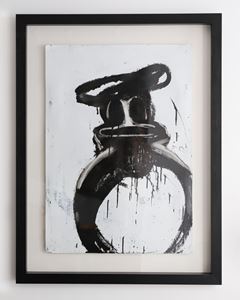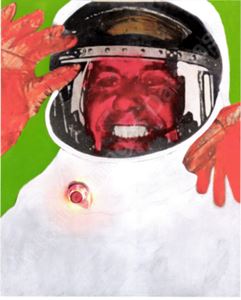Dumas+Limbach - Fine Art
35 Avenue Matignon
France 75008 PARIS
France
Phone : +331 42 89 01 09
Mobile Ph. : +336 49 33 76 58
Email : matignon@dumaslimbach.com
URL : www.dumaslimbach.com
About
About us
Specialized in Modern art, Contemporary art and the Post-war period, Dumas+Limbach Fine art was born from a love story and a passion for art that found its place over the years. After many years of research and acquisitions, the gallery was born in 2022 in Saint-Tropez and has been a real success.
Following this first summer opening, Dumas+Limbach fine Art decided to come and settle on the prestigious Avenue Matignon in Paris, thus exhibiting with the greatest and offering a vast and varied collection, almost unprecedented, for connoisseurs and amateurs of art. From New figuration through Raw art, Abstract art, Op art, Narrative figuration, Free figuration, or even Support/Surface and again the CoBrA Group, it is a real treasure of art waiting to be admired.
You can then observe the unique works of Claude Viallat, the paintings of Hans Hartung, Michel Macréau or Maryan S. Maryan; admire the bright colors and shapes of Robert Combas; Adboulaye Konaté‘s interplay of textures; the creations of Roger Capron, Jean Hélion, Claude Venard; the sculptures of César Baldaccini and the illustrious Bernar Venet; or even the works of Bengt Linsdström, Jean Miotte, Geroges Jouve, Jean-Michel Atlan, Jean-Pierre Pincemin, Julien Vignikin; observe the nuances of Alexander Calder‘s gouaches; appreciate there the works of Geer Van Velde, Mario Schifano, Pierre Ambrogiani; the lines of Bernard Buffet; the powerful works of Serge Poliakoff or even admire the essential creations of Jean Prouvé; and still so many other artists and works of art to discover.

Joyce Pensato Untitled

Bernard Buffet Water Street Wall Street

Fernand Léger Composition au camée jaune

Antonio Segui La Calle

César Baldaccini L'homme oiseau

Claude Viallat N°159

Franz Kline Brooklyn

Martial Raysse Espace zéro








1994
Enamel paint on paper
103 x 73 cm | 134 x 102 cm (framed)
Joyce Pensato (American, born 1941 in Brooklyn) is a contemporary painter, known for her large-scale cartoon canvases on black-and-white enamel. Her father, an engraver, encouraged her to pursue art studies. She studied at the New York Studio School, where she developed an interest in pop culture elements, starting with Batman. This served as a catalyst for her project of splashy canvases depicting well-known characters and mascots, such as Homer Simpson, Donald Duck and Mickey Mouse.
Solo exhibitions have been held at Museum of Contemporary Art, St. Louis (2017); Museum of Contemporary Art, Chicago (2016); Kunstraum Innsbruck, Innsbruck, Austria (2016); Fort Worth Museum of Modern Art, Fort Worth, Texas (2015); and Santa Monica Museum of Art, Santa Monica, California (2013). She is represented by Petzel Gallery, New York, where she has had four solo shows; Lisson Gallery, London, where she had solo shows in 2017 and 2014; Corbett v Dempsey, Chicago; and Grice Bench, Los Angeles. She has also exhibited with Galerie Anne de Villepoix, Paris (2010, 2000, 1998, 1996, 1994). Pensato's work is in the permanent collections of the Museum of Modern Art, New York; San Francisco Museum of Modern Art; Hammer Museum, Los Angeles; Dallas Museum of Art; St Louis Museum of Art and FRAC des Pays de la Loire.
Mixed media on canvas
146 x 114cm,
1989
BERNARD BUFFET was born on July 10, 1928, in the 9th arrondissement of Paris. Son of Charles Buffet, director of the GuenneNote mirrorware company, and his wife Blanche, née Colombe, he came from a cultivated, petty-bourgeois background, going against the legend that he lived in extreme poverty. Both his grandfathers were military men. One of them had a passion for drawing. He was raised with his brother Claude, five years his senior, in the 17th arrondissement of Paris, where he began painting and drawing at the age of ten.
In July, he exhibits La Ravaudeuse de filet at the Salon d'Automne, where he meets André Minaux. With Minaux, Jean Couty and Simone Dat, he joins Bernard Lorjou, Yvonne Mottet, Gaston Sébire, Paul Rebeyrolle and Michel Thompson in the L'homme témoin group. In 1949 Pierre Descargues publishes Bernard Buffet with Presses littéraires de France. Bernard Buffet marries Agnès Nanquette (1923-1976), a Beaux-Arts classmate, from whom he divorces the following year.
An art lover provides him with a bungalow in Garches. As rent, Bernard Buffet gives her one painting a quarter.
Bernard Buffet meets Pierre Bergé in 1950, "in a café on the rue de la Seine, now defunct, Chez Constant" Pierre Bergé becomes his companion, managing his career until they break up in 1958.
In 1952, the City of Paris awarded him the Antral prize, endowed with one hundred thousand francs. He went to the Place des Vosges, where M. Darfeuille introduced him to drawing
Oil on canvas
signed F. LÉGER. and dated 31 (lower right); titled Composition au CAMÉE jaune, signed F. LEGER and dated 31 (on the reverse)
Certificate issued by Irus Hasma
Private collection, Paris (acquired by 1966)
Galerie Louise Leiris, Paris (acquired by 1968 and until at least 1990)
Acquired by the present owner in 2013
Acrylic on canvas,
2018
92 x 73 cm | 96 x 77 cm (framed)
ANTONIO SEGUÍ is an Argentine artist. Although he describes himself as an independent artist, Antonio Segui has often been associated with the narrative figuration movement.
After a first exhibition in Argentina in 1957, his work was revealed in Europe in 1963 at the III Biennale de Paris, which was followed by exhibitions in the world's leading museums.
In his early years, the artist practiced expressionist figuration imbued with irony, tending towards the absurd over the years. His works, depicting a colorful, graphic world that seems straight out of the world of comic strips, evolve against a backdrop of urban agitation, and seem to carry within them images of the night, the city and his native country, which he brings to life using charcoal, pastel, pencil or pen.
Antonio Segui supplants existential anguish with humor and facetiousness, creating a kind of theater on whose stage a man in motion frolics in search of his place in the world. Through his works, Antonio Segui orchestrates in his own way the hopes and follies of a human comedy, falsely naive, ironic and disquieting.
The military of the Argentine dictatorship would eventually ban him from the country, and Antonio Segui would say: "I didn't set out to attack them directly, but some not very intelligent people think that when you're not with them, you're against them."
1985
Bronze welded and patinated
Signed and numbered HC 2/2 (from an edition of 8 + 4HC/EA)
Stamped by the Bocquel foundry Work listed in the Durand Ruel Archives H 41 cm x W 61 cm x D 17.5 cm
41 x 61 x 17.5 cm
CÉSAR BALDACCINI is a French sculptor.
Part of the New Realism movement born in 1960, he is the creator of the trophy for French cinema's César awards ceremony, as well as the previous trophy for the Bocuse d'or cookery competition.
After completing his studies, unable to work in stone as the material was too costly, the artist turned to other materials such as plaster and iron (1947), creating his first sculptures with materials recovered from scrap yards (tubes, bolts, screws), materials which are also found in the Venus de Villetaneuse (1962).
Numerous exhibitions followed (Venice Biennale, Galerie Lucien Durand, Sao Paulo Biennale, Documenta II).
In 1961, César Baldaccini became close to Marino di Teana and joined the Nouveaux Réalistes group.
Throughout his life, the artist cultivated his image as an eternal craftsman, welder and, above all, great seducer, using a variety of distinctive techniques, such as the compressions he overexploited from 1980 onwards in the Reinventions of his earlier sculptures, then, from 1985 onwards, the comeback with the Poules patineuses series and, finally, the Reliefs, whose compositions are made from old jugs.
In his final years, he held numerous exhibitions and retrospectives (at the Galerie nationale du Jeu de Paume, then in Paris in 1997, as well as in Malmö, Milan, Sao Paulo and Mexico City) and then ended his career with a series of self-portraits that brought him face to face with death.
It was twenty years after his death that César Baldaccini was exhibited by the Centre Pompidou, which recognized his "major contribution to the history of sculpture".
Acrylic on textile plaster
1991
198 x 198 cm
CLAUDE VIALLAT French painter Claude Viallat is one of the founders of the Supports/Surfaces movement, and has been considered one of the leading artists on the French scene since the 70s and 80s.
Born in Nîmes in 1936, where he now lives and works, Claude Viallat came to painting by chance, first at the École des Beaux-arts in Montpellier (1955-1959), then at the École des Beaux-arts in Paris (1962-1963). As a teacher in his own right, Claude Viallat encouraged his students to find their own signature. He found his own in 1966, in the midst of an experiment. Together with Vincent Bioulès, Marc Devade, Daniel Dezeuze and many others, Claude Viallat founded the Supports/Surfaces movement in 1969. Together, they renounced the stretcher and the stretched, primed canvas, marking the end of the painting as it had existed since the Renaissance. They called for a renewal of art by questioning traditional materials.
Viallat began working on industrial tarpaulins, on which he repeated over and over again the same abstract shape that had become his signature, a cross between a sponge, a bean and a jack bone. Stencilled on a variety of surfaces, this motif opens up a reflection on the meaning of the creative gesture and the status of the "work of art". In so doing, Claude Viallat took part in a radical critique of lyrical abstraction, which gave rise to a unique work on color, placing it both as a source of inspiration and as a means of expression.
1950
mixed media on Ethyl Corporation advertising paper
47 x 89 cm | 110 x 68 cm (framed)
Report on this work "Brooklyn" by Stephen Foster, the expert and author of the Franz Kline catalog raisonné dated September 10, 2017.
Certificate of authenticity by Stephen Foster Inscribed in the F. Kline archives.
Titled, signed "Kline" and monogrammed.
Franz Kline was an American painter of the 20th century. He was born on May 23, 1910 in Wilkes-Barre, Pennsylvania, and died on May 13, 1962 in New York. Like his friend Willem de Kooning, he was one of the leading figures of Abstract Expressionism, based mainly (but not exclusively) in New York in the 1940s and 1950s. He practiced action painting, painting large canvases in black and white according to pre-established patterns.
Franz began his elementary studies at Girard College. But he also studied academic art at the School of the Museum of Fine Arts, Boston and Heatherley's School of Fine Art of London (1937-1938). Returning to New York in 1939, he painted caricatures and scenery, then began to paint landscapes and portraits. Towards the end of the 1940s, he began his cycle of black-and-white paintings, as well as the large-scale formats characteristic of his style. He died prematurely in 1962. A retrospective exhibition was held the same year.
1963
Silver paint and oil on photograph mounted on canvas, light bulb, electrical system electrical system and Plexiglas
102.5 x 83.5 cm
Exhibiting Artists
